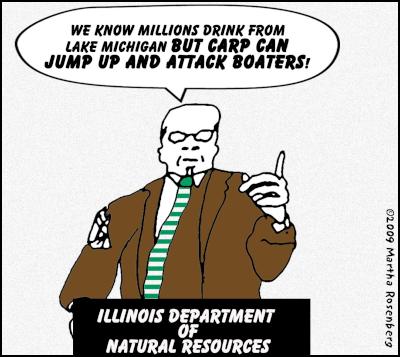Fish Killed, Waterways Poisoned by State Agency
Fish Killed, Waterways Poisoned by State Agency... for No Reason
by Martha Rosenberg,Chicago
It's been a year since the Illinois Department of Natural Resources poisoned all the fish in Lincoln Park's South Pond to "restore" the water body into a "model Illinois freshwater habitat." Most of the world was watching the events a mile away in Grant Park as Barack Obama was named 44th President of the United States.
Tens of thousands of goldfish, koi, bass, crappie, catfish and sunfish/bluegill hybrids which inhabited the pond for 140 years suffocated and struggled to the surface after state "environmentalists" poisoned the water with Rotenone. Soon the lagoon sported a slick of shiny, golden and still moving fish like a macabre layered bar drink.
The irony of killing the fish to save the pond was not lost on Chicago residents who have enjoyed the fish from rented paddle boats on the 5.2 acre pond for generations.
"It takes such a long time for them to grow and they're just gonna kill them off," lamented Carlos de la Pena to CBS news.
This week Illinois DNR practiced its poisonomics again and dosed six miles of the Chicago Sanitary and Shipping Canal (CSSC) to save the $7 billion sport fishing industry from invasive carp and protect boaters from being "attacked" by carp which can "leap out of the water" and strike them.
The Chicago Sanitary and Shipping Canal connects Lake Michigan and the Chicago River with the Mississippi River.
Ninety tons of dead fish are expected because Rotenone suffocates all fish equally--luckily the canal held mostly "non sport fish" like goldfish and gizzard shad say authorities--but a day after dumping 2,000 gallons of Rotenone, only one carp was found. Oops.
It's hard to believe that IDNR, the US Army Corps of Engineers, US Environmental Protection Agency, US Fish and Wildlife Service, US Coast Guard, USDA Animal and Plant Health Inspection Service, Chicago Department of Environment, Metropolitan Water Reclamation District of Greater Chicago, Midwest Generation, Great Lakes Commission and Great Lakes Fishery Commission could collectively--or individually-- be that dumb.
That they would waste our tax dollars and kill perfectly healthy wildlife for no reason.
But it is even harder to believe government natural resource stewards would poison a waterway connected to a lake three million people drink from for the one percent or less of the population who sport fish!
While officials say Rotenone is not harmful to humans "if used correctly" and "the nearest public drinking water system downstream is 125 miles from the CSSC," they also said carp were in the canal.
Of course government wildlife agencies' tax-funded gratuities to sportsman are nothing new.
Despite Illinois' $750 million budget gap the IDNR maintains a 20,000 square foot breeding facility, Helfrich Wildlife Propagation Center, on the southern edge of Edward R. Madigan State Park near Lincoln, where 150,000 pheasants are hatched and raised for state-sponsored controlled hunts at state parks. Think Dick Cheney hunting.
"Illinois schools are losing money, state parks are scheduled to close and some state workers only recently started getting their paychecks on time. But pheasant hunters around the state still have reason to smile: Illinois will spend $1.4 million this year to mate, hatch and raise ring-neck pheasants for hunting at 16 state conservation areas. And it will recover only $1 million of that," the Peoria Journal Star said of the program a few years ago.
Minutes from a 2005 Illinois DNR Advisory Board meeting confirm that the $9 that is spent to raise each bird creates an operational loss and Illinois Office of Management and Budget spokeswoman Kelley Quinn said "raising pheasants at a financial loss, just so they can be killed" was a "not our top priorities" last year.
But the program dodged a legislative bullet and is alive and kicking, providing "recreation" to adults and children this fall and winter on public lands.
Illinois citizens may be without jobs, healthcare and sometimes homes but thanks to IDNR they have a steady stream of pheasants to shoot and are safe from carp attacks.
ENDS



 Binoy Kampmark: Catching Pegasus - Mercenary Spyware And The Liability Of The NSO Group
Binoy Kampmark: Catching Pegasus - Mercenary Spyware And The Liability Of The NSO Group Ramzy Baroud: The World Owes Palestine This Much - Please Stop Censoring Palestinian Voices
Ramzy Baroud: The World Owes Palestine This Much - Please Stop Censoring Palestinian Voices Dee Ninis, The Conversation: Why Vanuatu Should Brace For Even More Aftershocks After This Week’s Deadly Quakes: A Seismologist Explains
Dee Ninis, The Conversation: Why Vanuatu Should Brace For Even More Aftershocks After This Week’s Deadly Quakes: A Seismologist Explains Martin LeFevre - Meditations: Meditation Without A Method
Martin LeFevre - Meditations: Meditation Without A Method Ramzy Baroud: Israel To Annex The West Bank – Why Now? And What Are The Likely Scenarios?
Ramzy Baroud: Israel To Annex The West Bank – Why Now? And What Are The Likely Scenarios? Binoy Kampmark: The Strawman Of Antisemitism - Banning Protests Against Israel Down Under
Binoy Kampmark: The Strawman Of Antisemitism - Banning Protests Against Israel Down Under